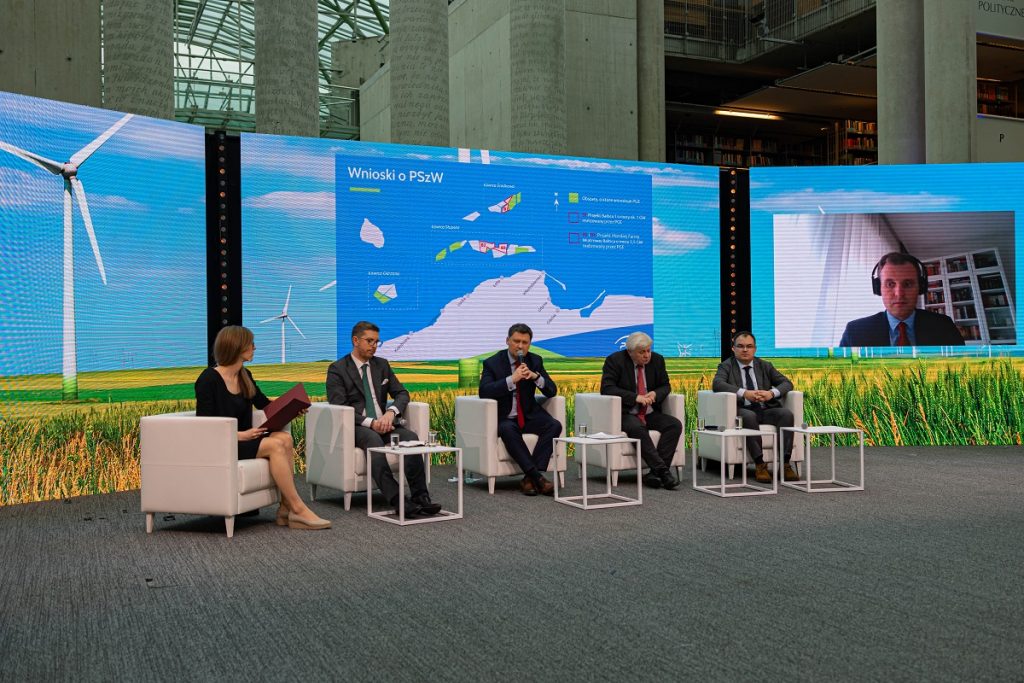PGE Baltica at ToGetAir 2022
On Wednesday, 20 April, the third edition of the international climate summit ToGetAir started. During three days of meetings and thirty debates, Polish and foreign experts will discuss renewable energy sources.
Prospects for the development of the offshore industry in Poland, the role of Polish companies, and the Baltic Sea itself were discussed during the debate “Offshore wind farms: technological, grid and organisational challenges”. Participants answered questions about the development and operation of the investment. Participants included: Dariusz Lociński – President of the Management Board of PGE Baltica, Włodzimierz Pomierny – Manager of the Offshore Wind Energy Project in the Industrial Development Agency, Sławomir Krenczyk – Executive Director of the Kazimierz Pułaski Foundation, Piotr Czopek – Director for Regulation in the Polish Wind Energy Association, Michał Jerzy Gołębiowski – Director of the Small and Medium Business Segment in Microsoft. The discussion was moderated by Marta Wierzbowska-Kujda, Editor-in-Chief of “Teraz Środowisko”.
The wide-ranging topic started with the development prospects for the offshore wind energy industry in Poland. Dariusz Lociński, President of the Management Board of PGE Baltica, spoke about PGE’s plans in this respect.
– Currently the PGE Group executes three offshore projects – Baltica 1, Baltica 2 and Baltica 3. The most advanced are Baltica 2 and Baltica 3, which PGE executes together with the Danish partner Ørsted. In January last year, PGE Baltica received a decision on environmental conditions for the offshore part of the Baltica 2 and Baltica 3 projects with a total capacity of up to 2.5 GW. Both power plants are to be ready by 2030. We plan to start the operation of Baltica 3 project in 2026 and Baltica 2 a year later. The largest offshore wind farm in our part of the Baltic Sea and one of the largest in the world is being built. In the case of Baltica 1, we are at the stage of examining the formal part, which will later allow us to build a model of the project and move on to the implementation phase. The commissioning of Baltica 1 is planned after 2030,” says Dariusz Lociński, CEO of PGE Baltica.
The Offshore Programme implemented by the PGE Group assumes construction of offshore wind farms with a total capacity of at least 6.5 GW by 2040, which makes it the leader of the future offshore wind energy sector. In addition to the initiated projects with a total capacity of up to approximately 3.5 GW, the group plans to acquire at least 3 GW of installed capacity in the Baltic Sea in the next stage.
– We have submitted eight applications for location permits for future offshore wind farms. In the case of six of them, we are the initiating party of the whole procedure on the government side. Our efforts are supported by in-depth knowledge in this respect – said the President of the Management Board of PGE Baltica.
Poland’s energy policy until 2040 speaks of 11 GW until 2040. PGE power plants would account for more than half of this capacity. Will the forecast from PEP2040 be revised?
– With the current market interest in our sector, the targets should be revised, but upwards. Already at this moment, while preparing for the Baltica 1 project, we see interest from partners who want to participate with us in its development. This sector is very promising for green change. But at the moment I do not see any threats that could stop the whole project of offshore energy in Poland. The only limitation that exists today is the possibility to build wind farms based on technology involving piling in the ground on the seabed. This is how the currently planned farms in the Polish part of the Baltic Sea will be built. When we enter the technology of floating foundations, larger areas of the Baltic Sea will immediately become available for development – said President Lociński.
After launching the Baltica 3, Baltica 2 and then Baltica 1 stages, PGE will have a total of almost 3.5 GW of installed capacity on the Baltic Sea, which will make it possible to power approx. 5.4 million households and satisfy approx. 8 per cent of the domestic demand for electricity.
Dariusz Lociński also answered the question to what extent the offshore development will stimulate the development of Polish science.
– A good way to define local content should be on two levels: business and science. PGE wants to create local content for offshore wind energy consisting in engaging Polish scientific thought into cooperation and technology development, which will give us an advantage in the future. The Gdańsk University of Technology, Gdynia Maritime University, Polish Academy of Sciences have already started cooperating with us, thanks to which we are successfully implementing research projects that precede the commencement of the construction of power plants offshore.
Source: Agnieszka Latarska/PortalMorski.pl




